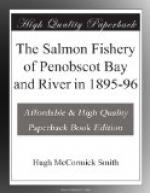On June 19, 1896 a Gloucester fishing vessel brought into Rockland a 10-pound salmon that had been caught on a cod trawl 20 miles southeast of Matinicus. The fish was sent home to Gloucester by the captain of the vessel, through Mr. Charles E. Weeks, a Rockland fish-dealer.
Several salmon have been taken on hooks off Frenchman Bay within a few years. One 25-pound fish was caught on a cod trawl 3 miles off Gouldsboro, in 20 fathoms of water, and another was taken southeast of Mount Desert Island in 35 fathoms.
Some years ago, on May 22, one of the crew of the schooner Telephone, of Orland, Me., while fishing for cod on German Bank, caught a 10-pound salmon. German Bank lies about 50 miles southeast of Mount Desert Island and has 65 to 100 fathoms of water.
Destruction of salmon by seals.
Seals are known to kill a great many salmon in Penobscot Bay and the lower river. They enter and leave the weirs and traps without difficulty and cause great annoyance to the fishermen. When a seal enters a net, the fish are frightened and usually become meshed; the seal may then devour them at its leisure. The initial bite usually includes the salmon’s head.
Fishermen in some places report a noticeable increase in seals in the past few years, and a consequent increase in damage done to the salmon fishery. The State pays a bounty of $1 each for seal scalps, which serves to keep the seals somewhat in check, although the sagacity of the animals makes it difficult to approach them with a rifle and to secure them when shot. Within a few years some weir fishermen have been obliged at times to patrol the waters in the vicinity of their nets, in order to prevent depredations. In the Cape Rosier region, where some salmon trap fishing is done, seals were very troublesome in the early part of the season of 1896. Mr. George Ames, who set three traps in 1896 and took about 100 salmon, had knowledge of 13 other salmon that were destroyed by seals while in his nets. Similar instances of relatively large numbers of salmon killed by seals might be given. With salmon worth 20 to 50 cents a pound the loss of 10 or 12 salmon by seals, in a total catch of 75 or 100, is a matter of importance to the fisherman.
Evidences of results of propagation.
The opinion is now practically unanimous among the salmon fishermen of Penobscot River and Bay that the artificial hatching of salmon by the U.S. Fish Commission is producing beneficial results. About the same arguments in support of their opinions are presented by all, and these accord well in the main with the observations of other persons who have given this matter attention:
(1) The opportunities for natural reproduction are exceedingly limited, owing to the obstructions to the passage of the fish to their spawning grounds in the headwaters of the Penobscot basin.
(2) The salmon that are naturally hatched are, even under the most favorable conditions prevailing at the present time, not numerous enough to keep up the supply of market and brood fish, with the fatalities incident to the long residence at sea and to the passage of immature fish down from the spawning grounds to the sea.




